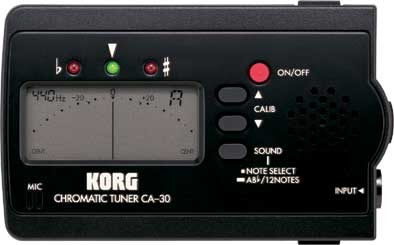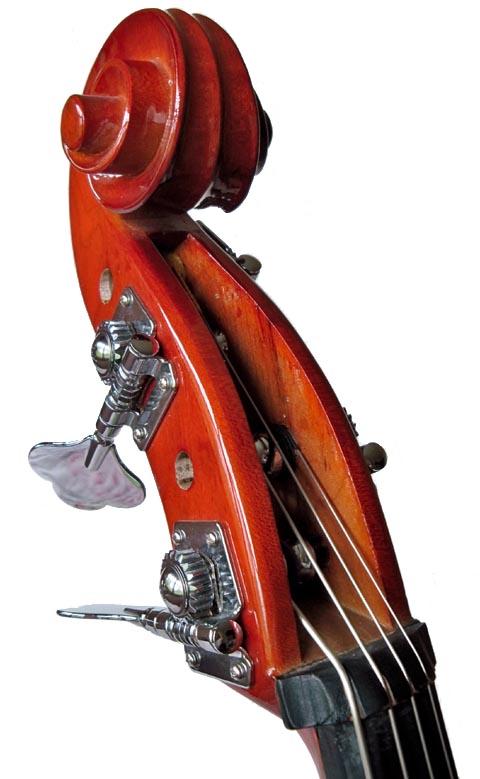The cello arrived two days ago. I was scared to open it and face the music. A flimsy cardboard box, some hunks of styrofoam, and the black nylon carrying bag were all that protected this fine instrument on its journey. I drew it from its bag unscathed and held it close, trembling a bit. The strings were loose and it had to be tuned. I called for my guitar-playing son to help me. At the piano, we figured out which C, G, D and A we were after and tried to match the pitches. Jonathan is used to tuning guitars with nifty worm geared heads and he was frustrated with the cello’s crude wooden pegs wedged in tapered holes. After a few minutes, a few grunts, and a disheartening twang, the A string was broken and I was sinking into despair. How am I going to play this thing if I can’t even tune it? I scooped up the cello, stuffed it in the bag and fled to my bedroom to sulk.
The next day, the engineer in me arose and considered the problem rationally. Granted, the wooden pegs are a sacred tradition of stringed instruments, and no good cellist would violate that tradition. Besides, if you play a $100,000 Strad, you’d be crazy to mess with it just to make tuning easier. But I have a $180 Merano and no luthier anywhere nearby, so I can do as I please.
 First stop is the web. First I find that I’m not the only one who finds the pegs unwieldy. There are geared tuners made especially for cellos (Cello Machine Heads), and even traditional-looking pegs with planetary gears hidden inside (Pegheds) so only your luthier knows for sure. Encouraged, I decide that the official cello solutions are too pricey for my cheap experiment, so I order a set of bright chrome bass guitar heads for $25 on eBay. I also order a Korg electronic chromatic tuner for $15. I left the cello in the corner for the next week and went on with my life.
First stop is the web. First I find that I’m not the only one who finds the pegs unwieldy. There are geared tuners made especially for cellos (Cello Machine Heads), and even traditional-looking pegs with planetary gears hidden inside (Pegheds) so only your luthier knows for sure. Encouraged, I decide that the official cello solutions are too pricey for my cheap experiment, so I order a set of bright chrome bass guitar heads for $25 on eBay. I also order a Korg electronic chromatic tuner for $15. I left the cello in the corner for the next week and went on with my life.
 The machine heads work perfectly. I would not recommend bass guitar heads for anything but a dirt cheap cello, since the shaft diameter requires drilling out the tapered peg holes, and the plates must be screwed to the outside of the pegbox with little woodscrews. But I don’t care. This is just an experiment, and very little money is at stake. After a day or two, the strings were stretched and the cello body compressed and now the thing stays almost perfectly in tune for days. And it only takes a minute or two with the Korg tuner to get it right when it does go a bit flat. I start with the C string and work up to the A, and it rarely requires a second pass. The cheapest cellos have plywood bellies and backs and I think that makes them more stable than better instruments.
The machine heads work perfectly. I would not recommend bass guitar heads for anything but a dirt cheap cello, since the shaft diameter requires drilling out the tapered peg holes, and the plates must be screwed to the outside of the pegbox with little woodscrews. But I don’t care. This is just an experiment, and very little money is at stake. After a day or two, the strings were stretched and the cello body compressed and now the thing stays almost perfectly in tune for days. And it only takes a minute or two with the Korg tuner to get it right when it does go a bit flat. I start with the C string and work up to the A, and it rarely requires a second pass. The cheapest cellos have plywood bellies and backs and I think that makes them more stable than better instruments.
Once the cello was tuned and playable, it had to be played. I discovered that the bow makes essentially no sound at all without rosin, and it takes a lot of rosining the first time. The cello came with a little block of cheap rosin that was rather like a piece of glass – brittle and crumbling. I was able to rough it up and get enough on the bow to play, but I promptly ordered some real Melos rosin on eBay.
Now the family gathered around for my debut, and we all thrilled to the first strains of “Twinkle, Twinkle”. I am now a cello student.
Ashley Silvey
August 26, 2010 at 10:53 pm
I’m about to buy this same cello. Do you recomend it for a starting cello?
jimmymc
August 27, 2010 at 8:00 am
It’s a great cello for the money, especially if you’re not sure you’re going to stay with it. My friend has a better Chinese (Cicilio) cello and also an old German cello and I’ve played them both. The better cellos certainly sound better and play more easily, but I still think the skill of the player makes more difference than the instrument. My cheap cello sounds beautiful when my friend plays it!
However, I did do a bit of work on mine to make it more playable – lowering the strings and trimming the fingerboard and replacing the tuning pegs. If you aren’t able to do that kind of work, you’d pay a luthier a lot more than the cello is worth to do it. So you might be happier paying more and getting a Chinese cello that is set up well by an American dealer. Take a look at sharmusic.com for example.
So that’s my qualified recommendation. If I was buying a 4/4 cello, now that I know I’m not quitting, I would go better than this one. If you’re paying for lessons, the cello cost will soon be small by comparison. But if money is really tight, and you’re going to try learning on your own, it’s a good way to get started. You won’t be able to sell it for much if you get a better instrument later.
Ashley Silvey
August 27, 2010 at 12:45 pm
Thank you! No one has been able to give me that much specific information. It was exactly what I needed to know. You’ve been really helpful!
Wryan
February 26, 2012 at 12:58 pm
considering doing this myself. Have the bass tuners and just realized I will have to drill the holes bigger so thought i’d look for other people’s experiences. Do you still feel it was a good move?
jimmymc
February 26, 2012 at 3:36 pm
No regrets putting the guitar tuners on my cheapo cello. But I would not use them on anything decent. They do work very well – no slipping, thanks to the worm gear, and very easy to adjust because of the high gear ratio.
The real cello machine heads at International Violin (http://www.internationalviolin.com/item_detail.aspx?ItemCode=34702) wouldn’t require enlarging the holes and should work just as well as the guitar machines heads since they also use worm gears. They still require small screw holes, but should not preclude returning to pegs.
See the later post about Finetune pegs. I’m still very happy with them and would use them on a nice cello, though because of the lower gear ratio, they are a bit touchier to tune. They are still working very nicely on my little cello. They don’t slip unless one gets bumped, so the cello stays in tune very well.
Michael Warner
May 16, 2012 at 7:42 am
I’ve played guitar for 45 years and am now trying violin. I’m considering the same idea. I’m not bound by classical convention. I think the wooden pegs are awful and unreliable. I think I’ll find a set of machine heads and assess the possibilities. Encouraged by your success.
jimmymc
May 16, 2012 at 7:57 am
Read my later post on Finetune Pegs. I like them better than guitar heads.
Cynthia Louise
March 4, 2013 at 11:53 pm
Thanks so much for the machine head info……I’m a guitarist trending to cello…an end to tuning frustration will be great…Thanks again…..
Emma
May 30, 2014 at 5:12 am
Hi there!
I was wondering if it was possible to get a photo of the machine heads of your cello from the front on, to see how the shafts sit? I’ve been inspired by your ingenuity! I have had RSI and struggling with the pegs can be difficult for me.. this seems like the perfect solution! However, my cello is a 1/2 size so the standard cello machine heads will not fit, and I’m exploring bass and guitar machine heads instead. I would be eternally grateful!!
Cheers,
Emma
jimmymc
May 30, 2014 at 7:10 am
Thanks for your comment. I gave the big cello to another budding cellist, so I can’t easily take a picture of it. I can tell you that the shafts are short and stubby and do not extend all the way across the pegbox. I drilled the peg holes on the side where the machine is mounted, but the opposite peg hole is unused.
Did you see my later post Finetune Pegs? These might work better for your smaller cello.
MJ
June 22, 2015 at 6:41 pm
Well, machines are noteasy to fit properly on a cello (which I know because I just spent an hour watching my cabinetmaker friend, who luckily has a workshop full of fancy tools, fit them to a travel cello project of mine) nor are they necessary for easy tuning. Available at amazon and any string shop are tailpieces with integrated fine tuners. They are not expensive (~$20) and easy to swap out yourself. The only time you will need then need the pegs is when you are changing strings, which will be 10 times easier than if you have machine heads. This I also know having just turned and turned and turned the machine head keys while putting on the strings. What a mistake that was. Once you drill the holes for the machine heads, there is no going back. Sorry, but I wish I had never seen this info, even for my travel cello. You REALLY do not want these on a rehular cello. Get a new tailpiece!
Grace
August 30, 2015 at 7:17 pm
I had to laugh when I saw the pic of your cello with bass guitar heads, I had the same problem when I was starting with the cello 7 mos ago, Its a good thing there’s a luthier from the school that I go to who was trained by the founder . I also have a chinese one, but my teacher said it has a nice sound. Do you own a more expensive cello now? :)